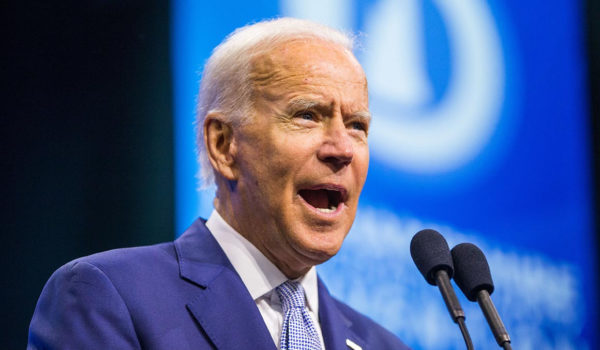
The calamitous developments in Afghanistan in the last week have made one thing abundantly clear. There is no national security leadership, as Americans are accustomed to having it, at the helm of state.
That formulation holds true whether you believe the responsible pubic officials are lost in a fog, in which case they are not acting as leadership; or believe that the leaders – whoever they are – have deliberately fostered this situation, in which case their leadership is decidedly not what Americans are accustomed to.
Note that “lost in a fog” does not mean incompetent. The individuals at issue have for the most part been in and out of public service for some time, and have varying degrees of competence in foreign and security affairs. Some of them know very well what they are about. In this case, “lost in a fog” is a colloquial way of expressing something more like institutional derangement.
Will this presidential election be the most important in American history?
The inputs from reality are there; we can all see them on our TV and computer screens. There’s no lack of decision-making “knowns.” The speaking-part people in their various posts keep speaking in complete sentences, with noun-verb agreement and, for the most part, pertinence to the overall topic. They just seem to be in a daze that delays and fatally limits action – perhaps even cognition? – day after day. They also keep blurting out impolitic utterances that obviously convey the truth about their perspective, but leave the American people appalled, incredulous, and increasingly wounded.
It’s well to take a moment and reflect on how we got this result. According to our official records, it’s because a whole bunch of people voted for Joe Biden in 2020.
This is not the place to hash over whether he really got 81 million votes in the general election. A zealous cottage industry is working on that question, and I wish them well. With all the documented discrepancies that emerged after 3 November, it is imperative that we track them down and at the very least determine how to prevent them in the future. That issue can be left to another debate.
In the meantime: in spite of a robust challenge from Bernie Sanders, and a notable if brief surge from Elizabeth Warren, Biden got over 19 million votes in the COVID-wracked primaries, some 2.1 million more than Hillary Clinton got in 2016. The Democratic field was much broader going into primary season in 2020 than it had been in 2016, and Biden’s top rivals had accumulated 16.7 million votes (9.6 million of them for Sanders) by the time the Democratic National Convention was held in August 2020.
The previous primary vote records had been set by Barack Obama and Hillary Clinton in 2008, both of whom got more than 17 million votes. (John McCain got 9.9 million on the GOP side.) Obama, of course, was essentially unopposed in 2012 and his 6 million-some primary votes that year reflected certainty about the Democratic nomination as much as anything else.
By any measure, the primary vote in 2020 was one of high turnout and seeming engagement, if we go by the numbers. Certainly it was on the Republican side: Trump ran essentially unopposed, as Obama had in 2012, but accumulated over 18 million primary votes (some 4 million more than his competitive-primary total in 2016).
Biden prevailed with Democrats by compiling a historically robust total that carried him past not only his chief rival, Bernie Sanders, but all his rivals combined.
Yet I doubt many people remember the primaries as an enthusiastic Biden-fest. COVID-19 is not really the reason for that. The reason is that Biden campaigned via computer from his basement den in Delaware – and that by fits and starts, sometimes going for days without being seen. COVID cannot explain the latter at all, and doesn’t explain the lack of in-person campaign appearances very well.

When Biden did show up in person, it was to address some dozen or so members of the press, who assembled obediently in white-circle distancing schemes that looked like something choreographed by M. Night Shyamalan. (For some reason, there was an abundance of hay bales stacked artistically behind Biden’s lectern for many of these appearances.)
— troy smith (@tropicaltroy68) August 22, 2021

By contrast, rivals Sanders, Warren, Buttigieg, Yang, Bloomberg, and a couple of others were out actually campaigning. Later in the season, Donald Trump was also on the campaign trail holding large rallies.
These events took place in spite of COVID restrictions. The American public decided earlier than most of us may remember that the coronavirus wasn’t a showstopper for political turnout. Particularly in the case of the campaign events for Sanders, Warren, and Trump, no one observing them would have thought Americans were fearful of getting out in a crowd to do politics. Actually voting at the polls, under the COVID threat, was a terror overhyped for political purposes by congressional Democrats and partisan factions in the states.
But Biden didn’t join the campaign trail – except when he did, and no one showed up. On some occasions, even though Biden was briefly present, the media had to be satisfied with photos of Jill Biden or a local candidate actually doing the rah-rah stuff.
Basically, everyone knew this was not due to any other cause than Biden’s declining cognitive faculties. His online interludes from the basement in Delaware made that clear.
For months America hardly ever saw Joe Biden, but awarded him the biggest primary vote total ever. The DNC was held “virtually” in August 2020, with almost no in-person appearances by top-drawer politicians, and Biden was nominated in absentia. He chose as his running mate Kamala Harris, who had suspended her own presidential campaign for lack of interest in December 2019, and thereafter compiled a total of 844 primary votes in New Hampshire and Arkansas, where she was still on the ballot.
Harris did a few campaign events in the fall of 2020, although she wasn’t going over well with voters, who failed to show up – as they continued to fail to show up for Biden’s rare public outings.

Throughout the campaign season of 2020, we are informed, a “cabal” (Time’s word, not mine) of “democracy-backing” activists labored to game out a terror that seemed to obsess them: that Trump wouldn’t leave office if he were defeated. In outlining this for the public, they used the fact that they were raising the issue as evidence that it needed to be raised as an issue.
In the fall, the cabal turned its energies to “fortifying” the election, a process the cabal’s chief chronicler, Molly Ball, acknowledged might be seen as, let’s be honest here, rigging the election, because the purpose was to make sure Biden won, since any Trump victory was bound to be achieved by nefarious means.
In due course, Biden received more than 81 million votes to Trump’s 74-odd million in the general election. Let us assume, as many are willing to do – many even determined to do – that 81 million people surged out to vote for the Democratic hermit candidate who had never drawn as many to a campaign event as Elizabeth Warren had, much less Bernie Sanders, because the voters were horrified at the thought of another four years of Trump.
There are multiple ways in which the numbers don’t make sense for that conclusion (e.g., there had to be an enormous surge in same-day voter registrations in some of the major cities that decided the battleground state tallies). But let us accept it anyway.
Nearly 10 months later, it is clear that those voters for Joe Biden in the 2020 primaries and general election, in their unprecedented millions, were chumps.
The stark reality is that they were manifestly chumps at the time. They voted in huge numbers for a candidate who could barely function and whom they rarely even saw in public. They voted for him even though he was basically an unknown variable, drawn from and beholden to a political party that was careering ever more extremely to the radical left.
By contrast, the intransigent people who didn’t vote for Biden recognized at the time what was wrong with voting for him, and differ now only in how little surprised they are at the result his election has produced.
In 2008, Obama and Clinton had to get out and ply the campaign circuit to tote up their respective 17 million-plus. In 2020, 19 million voters who couldn’t name one actual accomplishment of Joe Biden’s and had hardly seen him since he left the vice presidency in 2017 pushed him through the primaries, and then multiplied their numbers not by three-odd but by an astonishing four to send him past Trump in November.

At each step along the way, the pundits claiming to explicate the Biden dynamics had superficially satisfying reasons for why smart, patriotic people, as opposed to snaggle-toothed white supremacist terrorist Trump supporters, were making the better choice by voting for the unseen, unheard candidate evidently suffering from a decisive onset of geriatric dementia.
The superficially satisfying reasons were conventional-thinking reasons. They assumed that all conditions were static, that all the same calculations must prevail in people’s political decisions, and that it was Trump voters who had something wrong with their heads.
Trump voters had seen it differently since 2015. In their view, conditions had not been static for some time, but in reality had been deteriorating for years. Most, I think, would have dated the onset to some time before Obama. Trump voters tended to be people who expected to be able to work and support themselves, and seeing that condition slip away from them was one of the biggest factors in their decision to go with Trump. They were tired of policy debates, held by people who make a living holding policy debates, gratifying only the people who held the policy debates, and resulting with each passing year in a greater worsening of non-static economic (and political) conditions for the millions of people who worked at more basic, materially productive things.
I divine this from observation, as I didn’t even vote for Trump in 2016. (I wrote in Ted Cruz in the general.) So take it for what it’s worth. Trump defeated the GOP field in 2016 because of the party’s cumulative record of holding snap-crackle policy debates and then delivering nothing but not quite as much regulation, economic sludge, and job loss as the Democrats wanted to.
The post-Reagan GOP solution on politics – what I call the Old Consensus – was not something millions of voters wanted to get back to. If it had really been compelling, it had any number of exponents in the 2016 primaries. Yet none of them got even as far as Ted Cruz: who, remember, is seen as a maverick irritant rather than an Old Consensus guy.
The Old Consensus certainly wasn’t something that motivated millions of erstwhile GOP voters to seek its revival through the circuitous method of electing God-knows-who to steer Joe Biden from one gaffe-laden media interaction to another. The Old Consensus was just that: an old consensus, familiar and even comforting to some, perhaps, but after years of crumbling tape at the margins, not a source of enthusiasm or energy. Its motivation extended only to a minor, invested fringe.
But that’s the narrative the smart people came up with. Democrats in the primaries rushed out to vote for the unseen candidate. Then smart people who were aghast at Trump, and whose energies were devoted not to offering a viable, compelling alternative in Republican venues but to railing against Trump voters, rushed out in their millions to vote for the unseen candidate in November.
Assuming all happened as the official public records attest, that’s the explanation for how 81 million votes got us Biden, and the ensuing institutional meltdown of the U.S. government in Afghanistan.
The explanation, even if it’s true, speaks very poorly for conventional thinking. If conventional thinking bought us this outcome, then as Mr. Bumble said of the law, conventional thinking is a ass.
Perhaps we may believe that 81 million people voted to elect the random, ill-defined quantity that was “Biden” in 2020. But that belief about the vote and its voters has no hope of persuading us that they were the ones making the smart choice. Let us resolve to never be so smart again – and start by not letting Biden-vote apologists frame the narrative on what’s happening with “reality,” and what we need to do about it.





